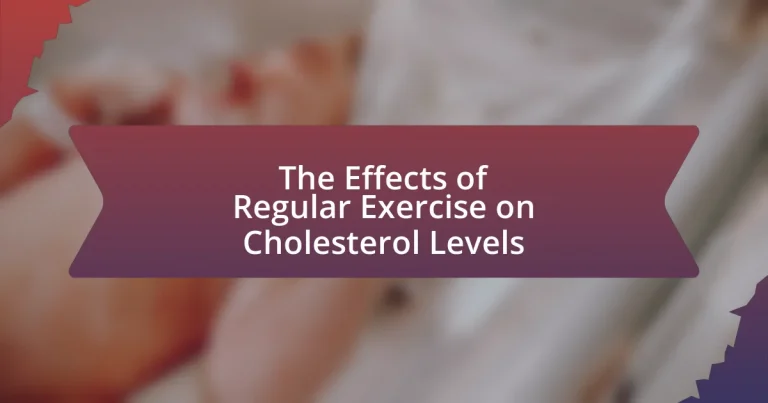Regular exercise has a significant impact on cholesterol levels, primarily by lowering low-density lipoprotein (LDL) cholesterol, often referred to as “bad” cholesterol, and raising high-density lipoprotein (HDL) cholesterol, known as “good” cholesterol. Engaging in moderate to vigorous aerobic activities can lead to a reduction in total cholesterol levels by approximately 5% to 10% and an increase in HDL levels by 3% to 6%. The article explores the mechanisms through which exercise influences cholesterol, the types of exercises most effective for cholesterol management, and the additional health benefits associated with improved lipid profiles. It also addresses practical strategies for integrating regular exercise into daily life and overcoming common barriers to maintaining an active lifestyle.

What are the Effects of Regular Exercise on Cholesterol Levels?
Regular exercise significantly lowers LDL cholesterol levels and raises HDL cholesterol levels. Engaging in physical activity helps improve the body’s ability to metabolize fats and enhances the efficiency of the cardiovascular system. Studies indicate that individuals who participate in regular aerobic exercise can experience a reduction in total cholesterol levels by approximately 5% to 10%, while HDL cholesterol can increase by 3% to 6% with consistent exercise routines. This positive impact on cholesterol levels contributes to a reduced risk of heart disease and stroke.
How does regular exercise influence cholesterol levels?
Regular exercise positively influences cholesterol levels by increasing high-density lipoprotein (HDL) cholesterol and decreasing low-density lipoprotein (LDL) cholesterol. Engaging in physical activity enhances the body’s ability to metabolize fats and improves overall lipid profiles. Studies indicate that moderate to vigorous exercise can raise HDL levels by 5% to 10%, while also contributing to a reduction in triglycerides and LDL levels. For instance, a study published in the Journal of the American College of Cardiology found that individuals who exercised regularly had significantly lower LDL cholesterol levels compared to sedentary individuals.
What types of cholesterol are affected by exercise?
Exercise primarily affects two types of cholesterol: low-density lipoprotein (LDL) and high-density lipoprotein (HDL). Regular physical activity is known to lower LDL cholesterol, often referred to as “bad” cholesterol, which can lead to a reduced risk of heart disease. Simultaneously, exercise increases HDL cholesterol, known as “good” cholesterol, which helps remove LDL cholesterol from the bloodstream. Studies have shown that individuals who engage in regular aerobic exercise can experience significant improvements in their cholesterol profiles, with a notable increase in HDL levels and a decrease in LDL levels, thereby enhancing overall cardiovascular health.
How do different intensities of exercise impact cholesterol levels?
Different intensities of exercise significantly impact cholesterol levels, with moderate to vigorous exercise generally leading to improved lipid profiles. Engaging in regular moderate-intensity aerobic exercise, such as brisk walking or cycling, can increase high-density lipoprotein (HDL) cholesterol, which is beneficial for heart health, while also lowering low-density lipoprotein (LDL) cholesterol and triglycerides. Research published in the Journal of the American College of Cardiology indicates that individuals who participate in at least 150 minutes of moderate-intensity exercise weekly can experience a notable reduction in total cholesterol levels. Furthermore, high-intensity interval training (HIIT) has also been shown to effectively improve cholesterol levels, as evidenced by a study in the Journal of Sports Medicine and Physical Fitness, which found that HIIT can lead to significant reductions in LDL cholesterol and triglycerides while increasing HDL cholesterol.
Why is cholesterol important for overall health?
Cholesterol is important for overall health because it plays a crucial role in the formation of cell membranes, hormone production, and vitamin D synthesis. Specifically, cholesterol is a structural component of cell membranes, which helps maintain their integrity and fluidity. Additionally, it is a precursor for steroid hormones, including cortisol and sex hormones, which are vital for various bodily functions. Research indicates that adequate cholesterol levels are necessary for optimal brain function, as the brain contains a high concentration of cholesterol, essential for synapse formation and neurotransmitter release.
What roles does cholesterol play in the body?
Cholesterol plays several critical roles in the body, including serving as a structural component of cell membranes, a precursor for steroid hormones, and a facilitator for the absorption of fat-soluble vitamins. Specifically, cholesterol is essential for maintaining membrane fluidity and integrity, which is vital for proper cell function. Additionally, it is a precursor for hormones such as cortisol, estrogen, and testosterone, which regulate various physiological processes. Cholesterol also aids in the absorption of vitamins A, D, E, and K, which are crucial for numerous bodily functions, including vision, bone health, and blood coagulation.
How can high cholesterol levels affect health?
High cholesterol levels can significantly increase the risk of cardiovascular diseases, including heart attacks and strokes. Elevated low-density lipoprotein (LDL) cholesterol contributes to the buildup of plaque in arteries, leading to atherosclerosis, which narrows and hardens the arteries. According to the American Heart Association, high LDL cholesterol is a major risk factor for coronary heart disease, which affects millions of individuals globally. Additionally, high cholesterol can lead to other health issues such as hypertension and peripheral artery disease, further complicating overall health.
What are the recommended types of exercise for improving cholesterol levels?
Aerobic exercises, such as brisk walking, running, cycling, and swimming, are recommended for improving cholesterol levels. These activities increase heart rate and promote cardiovascular health, which can lead to higher levels of high-density lipoprotein (HDL) cholesterol, often referred to as “good” cholesterol. Research indicates that engaging in at least 150 minutes of moderate-intensity aerobic exercise per week can significantly lower low-density lipoprotein (LDL) cholesterol, known as “bad” cholesterol, and improve overall lipid profiles. A study published in the Journal of the American College of Cardiology found that individuals who participated in regular aerobic exercise experienced a notable reduction in LDL cholesterol levels and an increase in HDL cholesterol, supporting the effectiveness of these exercises in managing cholesterol levels.
What aerobic exercises are most effective for cholesterol management?
Aerobic exercises that are most effective for cholesterol management include brisk walking, running, cycling, swimming, and dancing. These activities have been shown to increase high-density lipoprotein (HDL) cholesterol, which is beneficial for heart health, while also lowering low-density lipoprotein (LDL) cholesterol and triglycerides. A study published in the Journal of the American College of Cardiology found that individuals who engaged in regular aerobic exercise experienced significant improvements in their lipid profiles, with a reduction in LDL cholesterol levels by up to 10% and an increase in HDL cholesterol by approximately 5%.
How does strength training contribute to cholesterol improvement?
Strength training contributes to cholesterol improvement by increasing high-density lipoprotein (HDL) cholesterol levels and reducing low-density lipoprotein (LDL) cholesterol levels. Research indicates that regular strength training can enhance lipid profiles, with a study published in the Journal of Strength and Conditioning Research showing that participants who engaged in resistance training experienced a significant increase in HDL cholesterol and a decrease in LDL cholesterol after 12 weeks of consistent workouts. This positive shift in cholesterol levels is attributed to the metabolic changes induced by muscle hypertrophy and increased energy expenditure during and after strength training sessions.
How can regular exercise be integrated into daily life?
Regular exercise can be integrated into daily life by incorporating physical activity into routine tasks and scheduling specific workout times. For instance, individuals can choose to walk or bike to work, take the stairs instead of the elevator, or engage in short exercise sessions during breaks. Research indicates that even 150 minutes of moderate aerobic activity per week can significantly improve cardiovascular health and lower cholesterol levels, as noted by the American Heart Association. By making these small adjustments, exercise becomes a natural part of daily activities, promoting overall health and well-being.
What are the barriers to exercising regularly for cholesterol management?
Barriers to exercising regularly for cholesterol management include lack of time, motivation, access to facilities, and physical limitations. Many individuals report that busy schedules hinder their ability to incorporate exercise into daily routines, with studies indicating that over 50% of adults cite time constraints as a significant barrier. Additionally, low motivation can stem from a lack of immediate results or enjoyment in physical activity, which can discourage consistent effort. Access to suitable exercise facilities or safe environments also poses a challenge, particularly in underserved communities where resources may be limited. Lastly, physical limitations due to health conditions or age can restrict the ability to engage in regular exercise, affecting overall cholesterol management.

What are the specific benefits of exercise on cholesterol levels?
Regular exercise significantly lowers LDL (low-density lipoprotein) cholesterol and raises HDL (high-density lipoprotein) cholesterol levels. Engaging in physical activity helps improve the body’s ability to metabolize fats and enhances the efficiency of the cardiovascular system. Studies indicate that moderate-intensity aerobic exercise, such as brisk walking or cycling, can lead to a reduction in LDL cholesterol by approximately 5-10% and an increase in HDL cholesterol by about 3-6%. This dual effect contributes to a healthier lipid profile, reducing the risk of heart disease and stroke.
How does exercise improve HDL cholesterol levels?
Exercise improves HDL cholesterol levels by increasing the production of high-density lipoprotein in the liver and enhancing its transport in the bloodstream. Regular physical activity, particularly aerobic exercises like running, cycling, and swimming, stimulates enzymes that help move cholesterol from the blood to the liver, where it can be processed and eliminated. Studies have shown that individuals who engage in moderate to vigorous exercise for at least 150 minutes per week can see significant increases in HDL cholesterol levels, with some research indicating an increase of 5 to 10 mg/dL in HDL for those who maintain a consistent exercise regimen.
What mechanisms are involved in raising HDL through exercise?
Regular exercise raises high-density lipoprotein (HDL) levels primarily through increased lipoprotein lipase activity, enhanced reverse cholesterol transport, and improved insulin sensitivity. Increased lipoprotein lipase activity facilitates the breakdown of triglycerides, leading to a higher concentration of HDL particles. Enhanced reverse cholesterol transport allows for more efficient removal of cholesterol from peripheral tissues to the liver, where it can be excreted. Improved insulin sensitivity, resulting from regular physical activity, also contributes to higher HDL levels by reducing the hepatic production of triglycerides, which inversely affects HDL metabolism. Studies have shown that aerobic exercise can increase HDL levels by 5-10% in individuals, demonstrating the effectiveness of exercise in modifying lipid profiles.
How significant is the increase in HDL from regular exercise?
Regular exercise significantly increases high-density lipoprotein (HDL) cholesterol levels. Studies indicate that engaging in moderate to vigorous physical activity can elevate HDL levels by approximately 5% to 10%. For instance, a meta-analysis published in the Journal of the American College of Cardiology found that individuals who exercised regularly experienced a notable increase in HDL, with aerobic exercise being particularly effective. This increase in HDL is associated with a reduced risk of cardiovascular diseases, highlighting the importance of regular physical activity in managing cholesterol levels.
How does exercise lower LDL cholesterol levels?
Exercise lowers LDL cholesterol levels by enhancing the body’s ability to metabolize fats and improving overall lipid profiles. Physical activity stimulates enzymes that help move LDL cholesterol from the bloodstream to the liver, where it is processed and eliminated. Studies indicate that regular aerobic exercise can reduce LDL cholesterol by 5% to 10%, contributing to better cardiovascular health. For instance, a meta-analysis published in the Journal of the American College of Cardiology found that individuals engaging in moderate to vigorous exercise experienced significant reductions in LDL levels compared to sedentary individuals.
What physiological changes occur that lead to lower LDL levels?
Regular exercise leads to lower LDL levels primarily through enhanced lipid metabolism and improved insulin sensitivity. During physical activity, the body increases the activity of enzymes that facilitate the breakdown of fats, which helps to reduce the concentration of low-density lipoprotein (LDL) cholesterol in the bloodstream. Additionally, exercise promotes the upregulation of LDL receptors in the liver, enhancing the clearance of LDL from circulation. Studies have shown that individuals who engage in regular aerobic exercise can experience a significant reduction in LDL levels, with some research indicating reductions of 5-10% in LDL cholesterol after consistent exercise routines.
How does weight loss from exercise contribute to LDL reduction?
Weight loss from exercise contributes to LDL reduction by improving lipid metabolism and enhancing the body’s ability to clear LDL cholesterol from the bloodstream. When individuals engage in regular physical activity, they often experience a decrease in body fat, which is associated with lower levels of circulating LDL cholesterol. Research indicates that a reduction in body weight can lead to a significant decrease in LDL levels; for instance, a study published in the Journal of the American College of Cardiology found that participants who lost 5-10% of their body weight through exercise and dietary changes experienced a notable reduction in LDL cholesterol levels. This mechanism is primarily due to improved insulin sensitivity and increased activity of enzymes that facilitate the breakdown of LDL particles.
What additional health benefits accompany improved cholesterol levels from exercise?
Improved cholesterol levels from exercise are associated with several additional health benefits, including reduced risk of cardiovascular disease, enhanced insulin sensitivity, and improved mental health. Regular physical activity lowers LDL cholesterol and raises HDL cholesterol, which contributes to better heart health and a lower incidence of heart attacks and strokes. Studies indicate that individuals who engage in regular exercise experience a 30-40% reduction in cardiovascular disease risk. Furthermore, exercise improves insulin sensitivity, which can help prevent type 2 diabetes, and it has been shown to alleviate symptoms of anxiety and depression, enhancing overall mental well-being.
How does exercise impact cardiovascular health?
Exercise significantly improves cardiovascular health by enhancing heart function and reducing the risk of heart disease. Regular physical activity strengthens the heart muscle, improves blood circulation, and helps maintain healthy blood pressure levels. Studies show that individuals who engage in consistent exercise have lower levels of LDL cholesterol (often referred to as “bad” cholesterol) and higher levels of HDL cholesterol (“good” cholesterol). For instance, a study published in the Journal of the American College of Cardiology found that moderate-intensity exercise can lead to a 5-10% reduction in LDL cholesterol and a 10-15% increase in HDL cholesterol. This favorable shift in cholesterol levels contributes to a lower risk of atherosclerosis and other cardiovascular conditions.
What mental health benefits are associated with regular exercise?
Regular exercise provides significant mental health benefits, including reduced symptoms of anxiety and depression. Engaging in physical activity stimulates the release of endorphins, which are chemicals in the brain that act as natural painkillers and mood elevators. Research published in the journal “JAMA Psychiatry” indicates that individuals who engage in regular exercise experience a 20-30% reduction in the risk of developing depression. Additionally, exercise has been shown to improve cognitive function and enhance overall emotional well-being, as evidenced by a study from the University of Vermont, which found that regular physical activity is associated with improved mood and reduced stress levels.

What practical tips can help maintain a regular exercise routine for cholesterol management?
To maintain a regular exercise routine for cholesterol management, individuals should aim for at least 150 minutes of moderate-intensity aerobic activity each week, such as brisk walking or cycling. This level of activity has been shown to lower LDL cholesterol and raise HDL cholesterol, contributing to better overall heart health. Additionally, setting specific, achievable goals and scheduling workouts like appointments can enhance adherence to the routine. Research indicates that consistency is key; a study published in the Journal of the American College of Cardiology found that regular physical activity significantly reduces cardiovascular risk factors, including cholesterol levels. Engaging in activities that are enjoyable can also improve motivation and sustainability of the exercise routine.
How can individuals set realistic exercise goals?
Individuals can set realistic exercise goals by assessing their current fitness level, defining specific and measurable objectives, and ensuring that these goals are achievable within a reasonable timeframe. For instance, a person who currently exercises infrequently might set a goal to engage in physical activity for 30 minutes, three times a week, rather than aiming for daily workouts immediately. Research indicates that setting SMART (Specific, Measurable, Achievable, Relevant, Time-bound) goals enhances the likelihood of success in fitness endeavors. A study published in the Journal of Sport and Exercise Psychology found that individuals who set specific and realistic goals were more likely to adhere to their exercise routines and experience positive health outcomes, including improved cholesterol levels.
What strategies can help overcome common obstacles to regular exercise?
To overcome common obstacles to regular exercise, individuals can implement strategies such as setting specific goals, creating a structured schedule, and finding social support. Setting specific goals, like aiming for 150 minutes of moderate aerobic activity weekly, provides clear targets that enhance motivation. Creating a structured schedule helps integrate exercise into daily routines, making it a non-negotiable part of life. Additionally, finding social support, whether through workout partners or community groups, can increase accountability and enjoyment, making it easier to stick to an exercise regimen. Research indicates that social support significantly boosts adherence to exercise programs, as noted in a study published in the Journal of Physical Activity and Health, which found that individuals with workout partners were 50% more likely to maintain their exercise routines.





